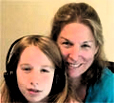Everyone knows Mother Goose, the jolly woman of legend who represents the beloved collection of English nursery rhymes. But who was Mother Goose really? Where did the name originate? Here are three of the best known theories…
The French Connection – Was Mother Goose Really French?
Some people believe Berthe de Laon (726 to 783), the Mother of Charlemagne, was Mother Goose. She became queen of the Francs when she married Pépin le Bref . One of her feet was bigger than the other, and so she was known by her subjects as “Berthe au grand pied” (in English “big-footed Bertha”). Berthe may also be the original model for la “Reine Pédauque” (in English “Queen Goosefoot”), a figure of French legend, whose statue is found in front of some churches in France.
This could be the origin of the legendary French figure, Goose-footed Bertha, who always has children around her listening to her stories.
In 1650, the first published mention of the name Mother Goose, is in French, in Loret’s La Muse Historique. The book contains the line “comme un conte de la Mère Oye” (in English “like a Mother Goose story”).
In 1697, Charles Perrault published Les Contes de ma Mère l’Oye, (in English “The Stories of Mother Goose”). Unlike later English language usage, here Mother Goose was a teller of stories, not a reciter of nursery rhymes. The book contains 8 fairy tales, including Little Red Riding Hood.
The American Connection – Could Mother Goose Have Been American?
Eliza Goose of Boston (probably short for Vertigoose or Vergoose) was the mother-in-law of a printer named Thomas Fleet. The story says that she often told nursery rhymes to her grandchildren. Supposedly, her son-in-law printed a book entitled Songs of the Nursery; or, Mother Goose’s Melodies for Children in 1719. There’s no proof that this book actually existed, except for the word of 3 people in the 19th century.
Did Mother Goose Actually Come from England?
Martha Gooch was a nursemaid who lived in Sussex in the early 1700’s. When people overheard her singing rhymes to the children in her care, she struck them as a bit odd. They began to tease her by calling her Mother Goose after Queen Goosefoot, the mother of Charlemagne.
Supposedly, one of Gooch’s employers overheard her reciting rhymes. He wrote them down and made a book of them in 1712 called Ye Melodious Rhymes of Mother Goose. This book however has never been proven to have existed.
The first printed edition of nursery rhymes collected under the name Mother Goose (as opposed to the fairy tales of Perrault, collected under the same name in 1697) was called Mother Goose’s Melody and was printed around 1765 in England.
I guess we’ll never know for sure who Mother Goose really was, but it’s fun to try to find out!
This article was posted on Friday, September 30th, 2005 at 9:21 pm and is filed under Countries & Cultures, English, English Nursery Rhymes, History of Nursery Rhymes, History of Nursery Rhymes, Languages, Mother Goose, Nursery Rhymes, The History of Mother Goose, United Kingdom. You can follow any responses to this entry through the RSS 2.0 feed. You can skip to the end and leave a response. Pinging is currently not allowed.
2 Responses to “Who was Mother Goose?”
Leave a Reply

























February 10th, 2006 at 2:22 pm
Hi, thought you may like to know that someone called Mother Goose was buried in the church of St Olave’s in Hart Lane London in 1586! No idea who she or he was!
Kathy
January 16th, 2011 at 2:54 pm
dear i want mother goose world how can i baughtd now i m live in chile